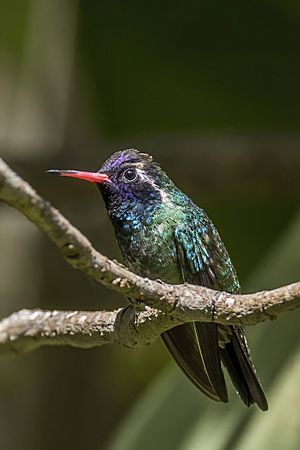White-eared hummingbird facts for kids
Quick facts for kids White-eared hummingbird |
|
|---|---|
 |
|
| In Guatemala | |
 |
|
| Showing chest and head feathers | |
| Conservation status | |
| Scientific classification | |
| Genus: |
Basilinna
|
| Species: |
leucotis
|
| Synonyms | |
|
Hylocharis leucotis |
|
The white-eared hummingbird (Basilinna leucotis) is a small, colorful bird. It's a type of hummingbird found in North and Central America. You can see it from the southwestern United States all the way down to Nicaragua. These birds are known for their bright feathers and the white stripe behind their eyes, which looks like a white ear!
Contents
About the White-eared Hummingbird
How Scientists Name Them
Scientists group animals together based on how they are related. The white-eared hummingbird's scientific name is Basilinna leucotis. For a while, scientists thought it belonged to a different group called Hylocharis. But in 2014, new studies showed it should be in the Basilinna group.
There are three slightly different types, or subspecies, of this bird. They are called B. l. leucotis, B. l. borealis, and B. l. pygmaea.
What They Look Like
White-eared hummingbirds are about 9 to 10 centimeters (3.5 to 4 inches) long. Males usually weigh about 3.6 grams (0.13 ounces). Females are a bit lighter, weighing around 3.2 grams (0.11 ounces).
Their bills are straight. Males have a red bill with a black tip. Females have a mostly blackish bill with some red or orange near the base.
Male Hummingbirds
Male white-eared hummingbirds have bright colors. Their forehead is a shiny violet or bluish violet. Their face is mostly black with a clear white stripe behind each eye. This stripe looks like a white ear! Their upper body is a bright metallic green or bronze-green.
Their tail feathers are also colorful. The middle ones are bright bronze-green. Other tail feathers are darker green or bronzy black with green tips. Their chin and upper throat are violet-blue, and their lower throat is a shiny emerald green. Their chest and sides are bronze or bronze-green.
Female Hummingbirds
Female white-eared hummingbirds look similar to males but are not as brightly colored. Their crown (top of the head) is dusky brown. They do not have the shiny chin and throat colors that males do. Their underside is pale brownish-gray or grayish-white with some metallic bronze-green spots.
Subspecies Differences
The B. l. borealis subspecies is a little bigger than the main type. Males of this subspecies have more white and less green on their undersides. The B. l. pygmaea subspecies is a bit smaller. It has less green on its lower throat and more white on its underside.
Where They Live
Their Home Range
The B. l. borealis subspecies lives in southern Arizona and parts of Mexico, including Sonora, Chihuahua, and Tamaulipas. Sometimes, it visits New Mexico and Texas. It has even been seen further north and east in the U.S.
The main subspecies, B. l. leucotis, is found in central and southern Mexico and into Guatemala. The B. l. pygmaea subspecies lives in El Salvador, Honduras, and Nicaragua.
Their Habitat
White-eared hummingbirds like to live in mountain areas. They can be found inside forests, in clearings, or along the edges of forests. They prefer forests with pine trees, pine-oak trees, or pine-evergreen trees. They live at high elevations, usually between 1,200 and 3,500 meters (about 3,900 to 11,500 feet) above sea level.
How They Behave
Movement
Most white-eared hummingbirds stay in the same area all year round. However, those in the U.S. and northern Mexico move south after the breeding season. Birds in the southernmost areas might move to different elevations depending on the season.
Feeding Habits
White-eared hummingbirds drink nectar from many different kinds of flowers and shrubs. They usually feed low to mid-level in the plants. They are quite protective of their feeding spots! They will chase away other white-eared hummingbirds and even larger birds like the broad-tailed hummingbird.
Sometimes, they sneak into the feeding areas of much bigger hummingbirds, like Rivoli's hummingbird, to get food. Besides nectar, they also eat small insects.
Reproduction
The breeding season for white-eared hummingbirds changes depending on where they live. In the northern parts of their range, it's from March to August. In places like El Salvador, it's from October to December.
Male hummingbirds gather in special areas called leks. Here, they sing and show off to attract females. The nest is shaped like a cup and is made from soft plant material. It often has lichens (small plant-like growths) on the outside. Nests are usually placed up to 6 meters (about 20 feet) high in a tree or shrub. Sometimes, several nests can be found close to each other.
The female bird lays two eggs and keeps them warm for 14 to 16 days. The young birds leave the nest (fledge) about 23 to 28 days after hatching. Sometimes, a female will raise two groups of chicks in one season.
Their Sounds
The song of the white-eared hummingbird is described as a "tedious, metallic chipping." It sounds like chi'tink chi'tink chi'tink or chi'dit chi'dit chi'dit. Sometimes, it's just a simple tink tink.
Their calls are "fairly hard, dry chips." They can be repeated steadily and sometimes turn into short, quiet gurgles. Another call is a sharp, metallic tchik or tink.
Conservation Status
The IUCN (International Union for Conservation of Nature) says the white-eared hummingbird is a species of "Least Concern." This means it is not currently in danger of disappearing. It lives across a very large area. Scientists don't know the exact number of these birds or if their population is growing or shrinking. However, no immediate threats have been found.
It is considered common in most places where it lives. Because it uses the edges of forests, it is less affected by habitat loss than some other forest birds.
See also
 In Spanish: Colibrí orejiblanco para niños
In Spanish: Colibrí orejiblanco para niños


